Locke & Key comic creators discuss the changes from book to screen
This weekend, season 1 of Locke & Key premiered exclusively on Netflix. But the story of the Locke family and their house full of magical keys did not begin life as a TV show; a few years ago, it was still just a comic series by writer Joe Hill and artist Gabriel Rodriguez. Originally published in six volumes from 2008-2013, Locke & Key was a magically engaging comic series that invoked classic fantasy stories like Sandman and The Chronicles of Narnia while still coming up with fresh ideas. It has often made a great recommendation for people interested in comics.
The TV show version of Locke & Key very much represents the characters and themes of the comic series, but also changes up some details in the adaptation process. EW caught up with Hill and Rodriguez to discuss the show, its relation to the comic, and the origins of Keyhouse.
ENTERTAINMENT WEEKLY: Tell me about your reaction when you sat down for the first time and watched these finished episodes. What was that like?
GABRIEL RODRIGUEZ: It was an incredibly interesting experience. Even knowing the story back and forth, [co-showrunners] Carlton [Cuse] and Meredith [Averill] took it from a new point of view and were able to surprise me in the way in which they handled the story and the characters, while at the same time being very faithful to the spirit of the source. The fact that I never distrusted what I was watching, considering that I could be their toughest viewer, was incredibly surprising and a fun experience.
JOE HILL: I think Carlton and Meredith nailed it. I love the show, and think it’s a tremendously exciting and addictive watch. What really jumps out at me is the tremendous sense of fun it has. It kind of fizzes.
RODRIGUEZ: There’s nothing of nostalgia in this show anywhere. I think that’s a very complicated thing to achieve. It’s fun to watch this story through the eyes of other creators who found a way to tell their vision and make something that’s not a translation of the comic, but making something new out of it. That’s incredibly exciting.
In my conversations with Carlton, he specifically referenced Gabriel’s two-page spread of the inside of Bode’s head from the first time the Head Key is used in the comic. It’s an incredible cornucopia of cartoons. In the show, the Head Key is depicted much differently. Whether it was the Head Key or the Crown of Shadows, what do you think about the way they altered various story elements for the show?
HILL: [That Head Key spread] is probably the most iconic image in the comic. I’ll say this: For years I have really wanted to see the shadow creatures come to life. I don’t think it’s a big spoiler to say we get to see them leap off the walls in season 1 of Locke & Key. It’s even better than I hoped it would be. It’s every child’s nightmare springing to life. When we see those shadow creatures come crawling off the walls, that’s really satisfying dark fantasy stuff.
RODRIGUEZ: In the show, they understood that what they had to be faithful to was the idea behind the keys, not the mechanics of how they work. In the comic, we were able to do certain things with the way we draw the magic, and the show needed to be different. The way you portray how the Head Key works in the comic, in which you can pop off the heads of the characters and go in, when you draw that, everything is blended by the way the line and color works so it all fits together. If you wanted to translate the same thing on screen it would have demanded an intense combination of props and CGI. It’s highly likely it wouldn’t have worked with that seamless blend the way it works in the comic. The way they took that idea and changed it into a landscape you walk into conveys the same purpose of the idea behind the key but in a way that works so well on camera.
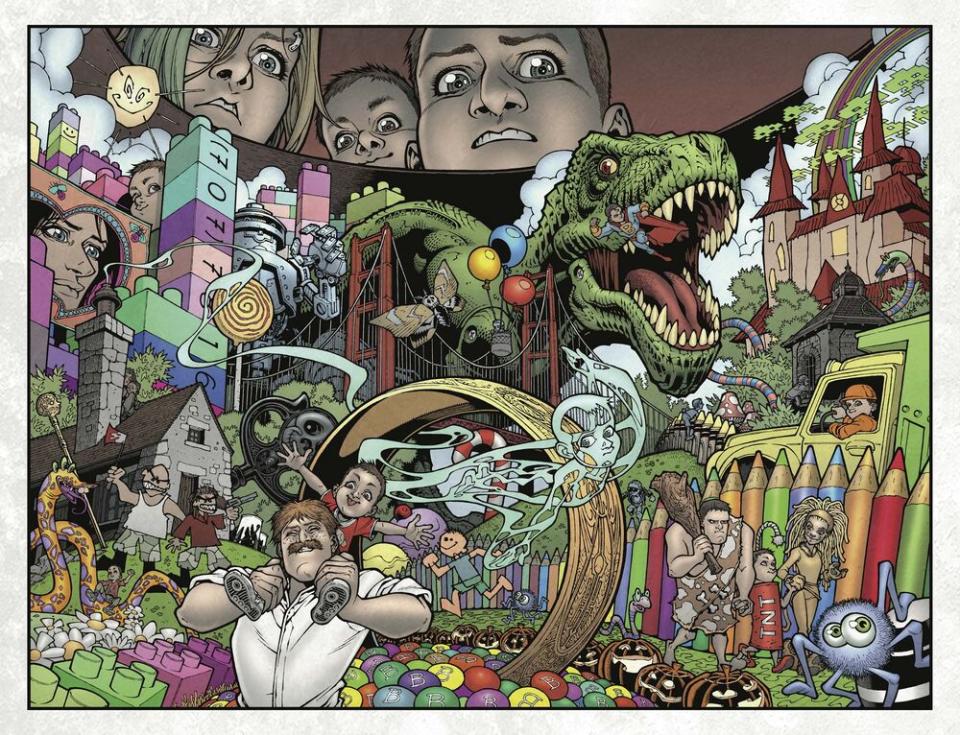
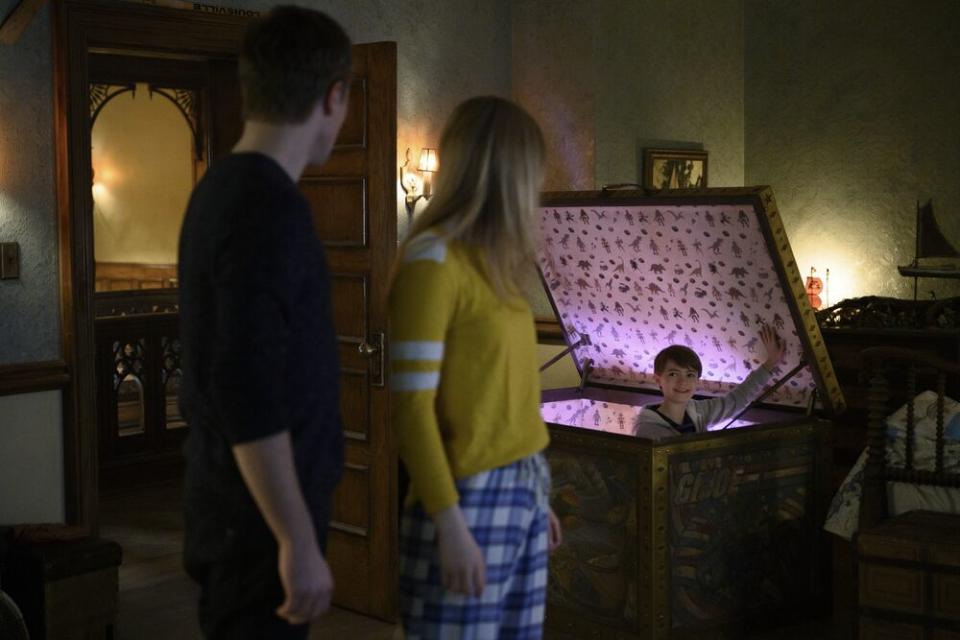
As a fan, I’ve been following the development of the show for years. What was that process like for you guys?
HILL: I think it’s interesting that people think that’s so unusual. When I have an idea for a story, I may fool with it for a few months or a few years. My second novel, Horns, that was my third attempt to explore an idea I had tried to explore in two other novels. I had been playing with those concepts for nearly a decade. I think Carlton and Meredith found their way to the best possible version of the story. That 10-year progression from the first attempts to develop the show back in 2010, coming from the world of publishing, that doesn’t seem that unusual to me. It can take time to get something right.
RODRIGUEZ: Sometimes it’s just that the idea that needs the right moment to happen. This was not one single project that took 10 years to happen, it was multiple different attempts to adapt. In a way, it was like when they first tried to make Lord of the Rings. The first time was George Lucas trying to make it, and that evolved into Star Wars. Then John Boorman tried to do it and that evolved into Excalibur. They had to wait for Peter Jackson and Weta to take Lord of the Rings to the screen. We were lucky in that each of the production teams that tried to make a show out of Locke & Key was incredibly good and talented. Any time it failed, it wasn’t for a reason related to the quality of the pilot, it was all circumstantial things that happened in the middle ground. It was great that when it finally happened, it was in the best possible conditions.
HILL: I think the takeaway is we’re basically like Lord of the Rings, only better.
Back at the beginning of Locke & Key, when it was first starting as your comic, what ideas and influences were in your heads?
HILL: I’ve always loved stories of portal magic. Like The Lion, the Witch, and the Wardrobe: The idea of turning a key and opening a door and stepping out of your world. I actually think books themselves are like magic cupboards, containing a whole tiny little universe for you to fall into. When I was first carrying the pitch around, that’s basically what I wanted to do: A story where the house would be kind of a character, and there would be all these keys that would let me play with all kinds of portal magic. We looked at different artists and some of them were good at drawing, like, intestines. There’s a place for that in some visceral horror fiction, but what I liked about Gabe’s characters was their luminous eyes and expressive faces. You could see what they were feeling in their body language and how they related to each other. Good stories of fantasy and dark wonder work well when you’re invested in the characters, so that when they’re in trouble you care about them. I wanted to work with Gabe because I thought his art was vivid and compassionate. And then once we started going, it was no longer just this story I had come up with, it was our story. I learned as much about the characters from the way Gabe drew them as he ever learned from anything I wrote. We sort of wound up like this old married couple. I’m working on a new Locke & Key story now, and when we were talking about Gabe said, what if we did this? And I was like ‘oh my god, that’s going right in.’ We trade a lot of ideas back and forth. It’s definitely our story.
RODRIGUEZ: Thinking about back then, I had already been working with IDW for a few years adapting books and movies into comic form. I wanted to do a creator-owned project in the vein of the stories that got me back into comics, which were the books Vertigo was publishing under Karen Berger: Sandman, Swamp Thing. I remember when they sent me the pitch. I was reading it in a bus on my way home and wasn’t able to believe how this was exactly the kind of story I wanted to do, but even better. The way Joe was handling magic combined with human drama immediately caught my attention. I thought this would be incredibly fun to develop in both graphic and storytelling terms. Incredibly weird vibing, It had the things I liked from Vertigo comics of the ’90s combined with Hayao Miyazaki movies. I knew we would have room to try something totally different from what was being published at that time in the comics industry. It was also an important personal journey for me in the way in which I shaped my adult life. I was able to make these amazing friendships with Joe and Chris Ryall our editor. It became an incredible experience. The passion and energy in the comics themselves is a reflection of that.
HILL: When I got married, Gabe designed my wedding ring. You look at the beauty of the keys, and I thought, ‘I want that on my finger for the rest of my life.’ There’s a group of people: me, Gabe, Chris, Jay Fotos who did the colors, Robbie Robbins who did letters. We became a kind of family. This family has expanded into people on the show, because Meredith and Carlton really get it.
When Gabe and I introduced a magic key in the comic, it was because we wanted to explore something about growing up. Each key has a magical power behind it, but they all explore something teenagers or people going through grief really experience. Using the Head Key, Kinsey removes her fear from her head, which happens both in the comic and the TV show. When we did that in the story, I thought to myself, a lot of teens go through a fearless streak, where they do things that in retrospect seem incredibly reckless and dangerous. Why would they do that? Because they feel they’re immortal, they can’t be broken, and they want to show the people they love that they’re ready to jump with both feet into life. I think guys, young men especially, want to be seen as unbreakable, unreachable, strong. So we used the Hercules Key as a way to show Tyler shedding his humanity to become this masculine loci of force. The Crown of Shadows is about the childhood fear of darkness under your bed, that it will become animate and come for you. Meredith and Carlton completely clicked to that.
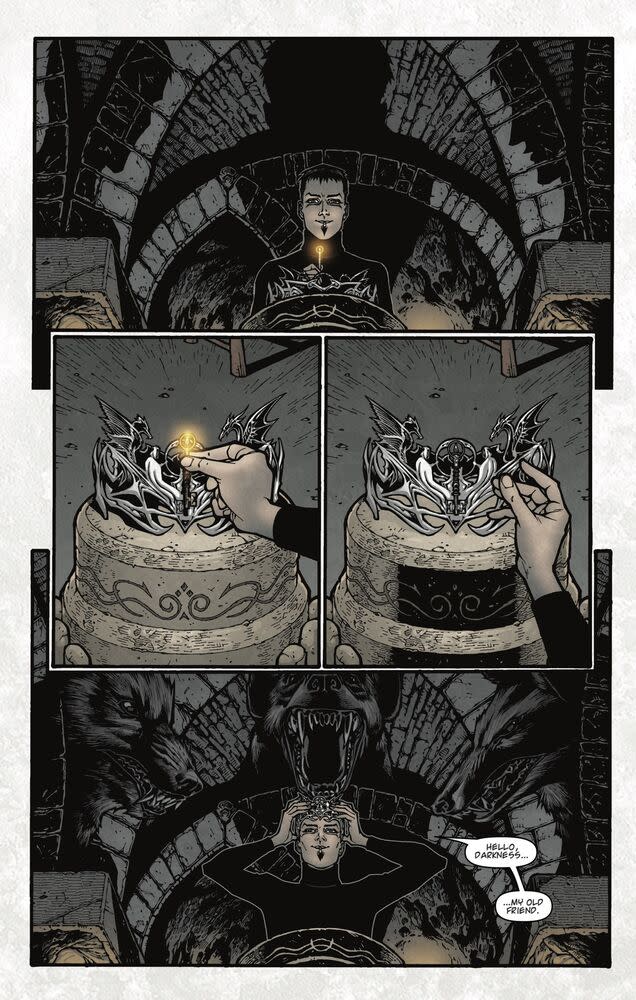
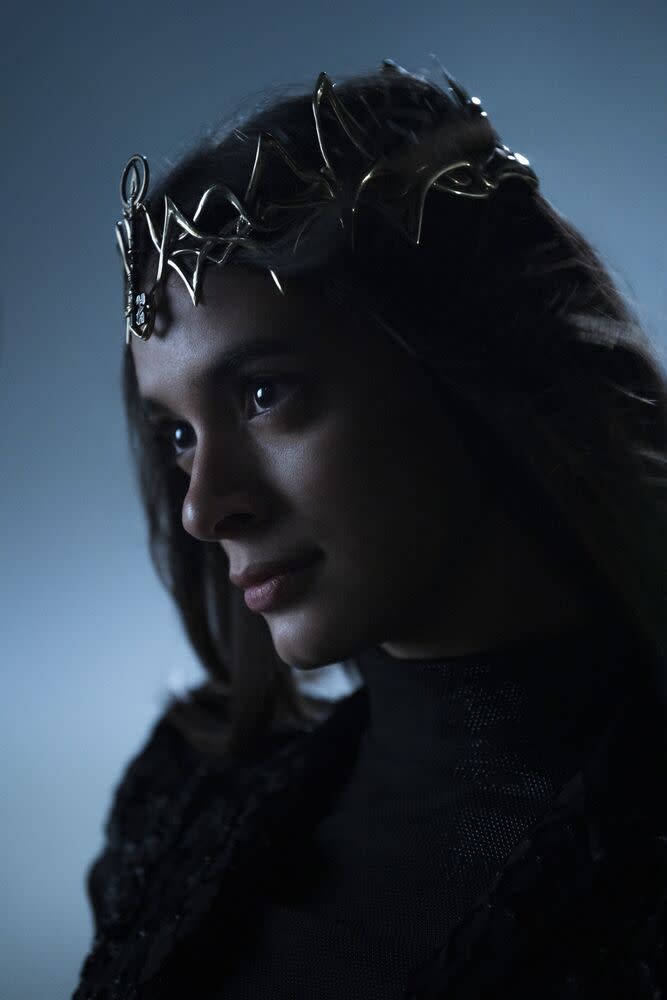
RODRIGUEZ: Another thing I think the show captures as well as we intended in the comic is this idea that even though these magic keys seem like the answer to problems, they are a shortcut without facing them, and that always has a consequence. The idea that by growing up you lose touch with magic, it’s because as an adult you shouldn’t be able to rely on magic shortcuts through the problems in your life. You need to face them and sometimes acknowledge you can’t solve them.
HILL: Gabe’s putting a positive spin on it. I think the reason grown-ups can’t see magic is because as you get older, there’s a tendency to trade imagination for resignation.
RODRIGUEZ: That’s the whole point, that you can have these different readings. Locke & Key was able to reach a diverse readership, which is unusual in comics. One of the most rewarding things was how many people have approached us to tell us this was the first comic they ever read. Having the chance to make this story a kind of gateway to this art form has been really rewarding and exciting.
HILL: It’s a gateway drug! You start with Locke & Key and think you’re okay, you think you just have a casual habit. And then you’re selling valuables to buy back issues of Saga, and you know you’ve messed up and there’s no going back.
There’s always some changes in adaptation. Sam Lesser (Thomas Mitchell Barnet) has less of a presence on the show than in the comic, and the gender-changing key and race-changing key got mixed into the Identity Key. What do you think about those changes?
HILL: It has to work as a TV show. It has to succeed in the possibilities and limitations of its own particular form. When we worked on the comic, we were always eager to make it successful as a comic, and there were things we could do that you couldn’t do in any other form. I always think about the issue we did that was a Calvin & Hobbes tribute. Or we did another issue where these two giants battle. But TV screens don’t change size, so you couldn’t achieve the same effect as going from small panels to full-page spreads. We made a comic that worked and thrived as a comic. It was the job of Carlton, Meredith, the cast, and the production team to make something that would succeed on its own terms as a TV show. My argument that they succeeded is it is basically like TV crack, it’s hard to stop watching once you’re into it.
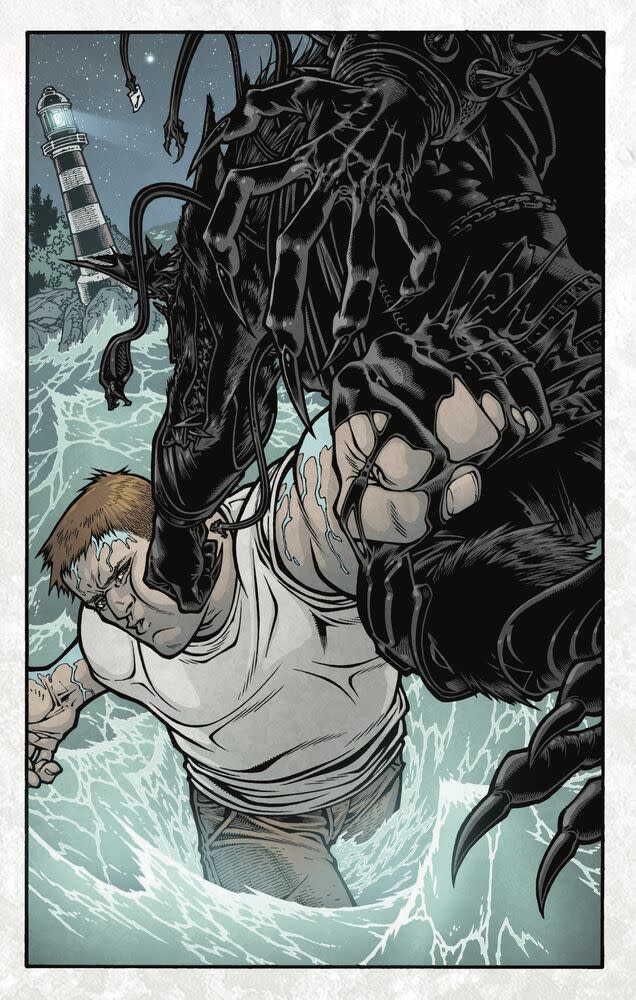
There is one thing which I’ve been thinking about a lot over the last week about how it changed. The comic is a horror comic in a lot of ways. The TV show is a work of dark fantasy that comments on horror. So there’s things like the Savini squad and their conversation about final girls. It’s not quite as meta as Scream or Cabin in the Woods, but I like that the show is in some ways more accessible as a work of dark fantasy, but the characters are also commenting on the tropes of fantasy and horror. That’s a really interesting choice, and a really satisfying one.
Related content:

